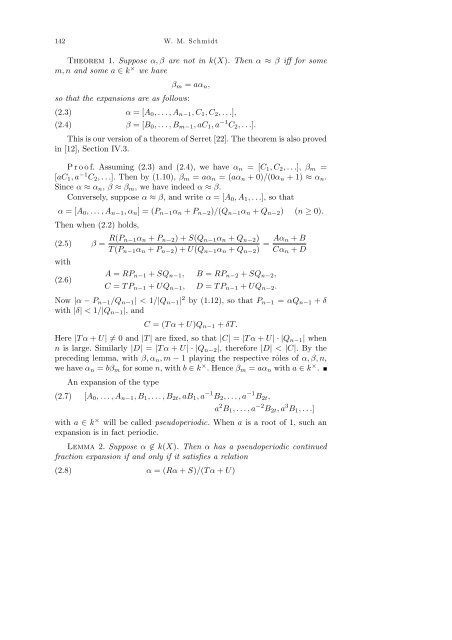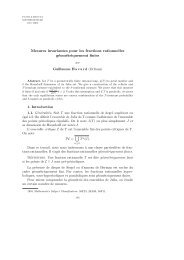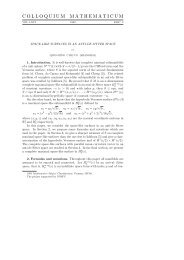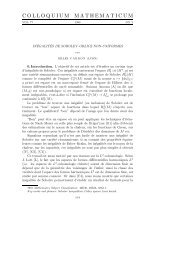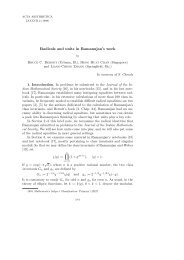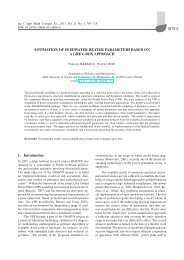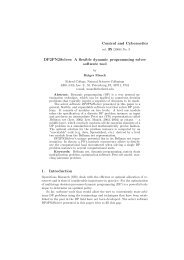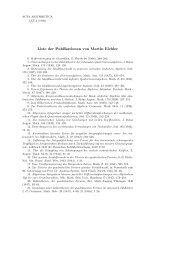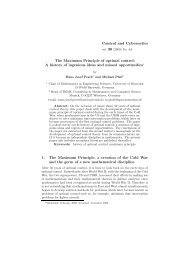On continued fractions and diophantine approximation in power ...
On continued fractions and diophantine approximation in power ...
On continued fractions and diophantine approximation in power ...
You also want an ePaper? Increase the reach of your titles
YUMPU automatically turns print PDFs into web optimized ePapers that Google loves.
142 W. M. Schmidt<br />
Theorem 1. Suppose α, β are not <strong>in</strong> k(X). Then α ≈ β iff for some<br />
m, n <strong>and</strong> some a ∈ k × we have<br />
so that the expansions are as follows:<br />
(2.3)<br />
(2.4)<br />
βm = aαn,<br />
α = [A0, . . . , An−1, C1, C2, . . .],<br />
β = [B0, . . . , Bm−1, aC1, a −1 C2, . . .].<br />
This is our version of a theorem of Serret [22]. The theorem is also proved<br />
<strong>in</strong> [12], Section IV.3.<br />
P r o o f. Assum<strong>in</strong>g (2.3) <strong>and</strong> (2.4), we have αn = [C1, C2, . . .], βm =<br />
[aC1, a −1 C2, . . .]. Then by (1.10), βm = aαn = (aαn + 0)/(0αn + 1) ≈ αn.<br />
S<strong>in</strong>ce α ≈ αn, β ≈ βm, we have <strong>in</strong>deed α ≈ β.<br />
Conversely, suppose α ≈ β, <strong>and</strong> write α = [A0, A1, . . .], so that<br />
α = [A0, . . . , An−1, αn] = (Pn−1αn + Pn−2)/(Qn−1αn + Qn−2) (n ≥ 0).<br />
Then when (2.2) holds,<br />
(2.5) β = R(Pn−1αn + Pn−2) + S(Qn−1αn + Qn−2)<br />
T (Pn−1αn + Pn−2) + U(Qn−1αn + Qn−2) = Aαn + B<br />
Cαn + D<br />
with<br />
(2.6)<br />
A = RPn−1 + SQn−1, B = RPn−2 + SQn−2,<br />
C = T Pn−1 + UQn−1, D = T Pn−1 + UQn−2.<br />
Now |α − Pn−1/Qn−1| < 1/|Qn−1| 2 by (1.12), so that Pn−1 = αQn−1 + δ<br />
with |δ| < 1/|Qn−1|, <strong>and</strong><br />
C = (T α + U)Qn−1 + δT.<br />
Here |T α + U| = 0 <strong>and</strong> |T | are fixed, so that |C| = |T α + U| · |Qn−1| when<br />
n is large. Similarly |D| = |T α + U| · |Qn−2|, therefore |D| < |C|. By the<br />
preced<strong>in</strong>g lemma, with β, αn, m − 1 play<strong>in</strong>g the respective rôles of α, β, n,<br />
we have αn = bβm for some n, with b ∈ k × . Hence βm = aαn with a ∈ k × .<br />
An expansion of the type<br />
(2.7) [A0, . . . , An−1, B1, . . . , B2t, aB1, a −1 B2, . . . , a −1 B2t,<br />
a 2 B1, . . . , a −2 B2t, a 3 B1, . . .]<br />
with a ∈ k × will be called pseudoperiodic. When a is a root of 1, such an<br />
expansion is <strong>in</strong> fact periodic.<br />
Lemma 2. Suppose α ∈ k(X). Then α has a pseudoperiodic <strong>cont<strong>in</strong>ued</strong><br />
fraction expansion if <strong>and</strong> only if it satisfies a relation<br />
(2.8) α = (Rα + S)/(T α + U)


